Clearly our customers have a breast obsession. We are selling far more chicken breasts than any other cut. Having a product that sells is great, but there’s a “however”.
Here, however, is the dilemma: breasts are selling too quickly, while drumsticks and the soup parts (necks and backs) are piling up. We aren’t part of the commodity market, so we can’t dump certain cuts on third world countries. I don’t want to be scoldy here, but it is true that sustainable eating involves the responsibility to eat all the edible parts of a plant or animal. We base our prices on the yield of each cut and the cost of producing it. We have to cover our bills. Organic chicken feed is expensive, and so is local butchering.

There are three ways we could resolve this problem.
First would be to breed chickens that have proportions corresponding to purchasing patterns. Breasts 50 percent bigger, thighs 30 percent bigger, drumsticks 50 percent smaller, wings about the same, and just a tiny amount of skeleton to hold the thing together. This option is the least desirable on a few levels…

The second option is for us to change our prices. You may have noticed that last month I rejiggered breasts, drumsticks, and thighs a few cents to try to reach some equilibrium, but breast sales actually increased without changing leg sales. So after running everything through a far-too-complicated Excel sheet to rebalance sales (once an engineer, always an engineer), I arrived at the following price revisions. This is a radical change, but it would scale price to match demand.

The third option would be for everyone to change their buying habits. For every four packages of breasts, we’d sell two packages each of thighs and drumsticks, one package of wings, and one of backs or necks. Perhaps some normalization will occur with backs and necks once cold weather arrives and people shift towards more soups, but I’m not sure we can continue to sell chicken cuts if we don’t get more drumsticks on more plates. There are only so many drumsticks that our family can eat.
So, my chicken-eating customers, what do you think? I don’t want to saddle anyone with drumstick guilt. We all have enough situations in our lives where people are telling us “you should feel guilty because you aren’t doing this!” If you like big breasts, that’s great. Not everyone needs to eat the legs, and certainly not every time. But I am interested in hearing how you weigh price versus preference. Somehow we’ve achieved a better balance in our pork and beef sales, so we need to figure out this chicken thing.

9 thoughts on “Breast Obsessed”
Well, I for one am in favor of cheap drumsticks and thighs! Those are the cuts I prefer anyway 🙂
Seems like the effect of healthy eating trends. Possible the trend would change when the next health and lifestyle advisory comes out: “eating the whole chicken is best for you!” 😀
It already has! As far as I’ve read, there is no health benefit to eating white meat. That idea was based on the notion that saturated fats were bad for us, but the only fat that has actually been demonstrated to have negative health effects is hydrogenated fats. The meat (and fat) of animals who forage for their own food is good for us.
Absolutely agree! I live in rural Philippines and with backyard grown chicken (and pigs), nothing goes to waste (snout to tail, head to butt! lol!). But as Dave had pointed out below, supermarket shopping convenience and white meat health fads has changed things a lot. I guess I was just wishful thinking that if some broad public health advisory had been put out, like “eat the whole chicken!”, then Dave’s problem would’ve been solved.Anyway, small changes do happen via consumers going to farmer’s markets, so there’s some advocacy for us to do there too!
Here the NYC vicinity there is a robust broth market in the cooler months. I don’t know if it’s possible but turning those backs into value added broths may be an option depending on your states value added/ processing laws.
I have another idea for you – find some wholesale outlet who doesn’t produce chicken and cut them off from the boneless breast before the other parts. Now where could you find a wholesale account willing to work with you on relatively small total volumes? *wink*
Hah. I’ve got to keep my Cairncrest Farm bros happy too, since I have so much of my meat stored in your freezers!
I have found that the quality of animal care I demand for chicken, those farmers only sell their chickens whole.
I think This could solve ypur problem, there might be a dip in sales for a while but anyone who wants free range birds will understand the farmers dilema, and get used to eating the whole bird again !! There is a mass food production and marketing lie that has consumers believing that fat ratio of white to dark meat is significant.
We all need to re-learn how to roast a whole chicken again. And remember ladies there’s Nothing as tasty as a juicy wing !
Yes, selling chickens whole makes the most sense for the farmer. But I also realize that some meals are best with one particular cut, so I don’t want to be unrealistic either. And some people just like what they like. We find it very challenging to attract customers since buying from farmers is always less convenient than shopping in grocery stores or through large home delivery aggregators.
We can adjust our sales through pricing with very lopsided prices, or our customers could make some changes in their eating habits, or we could meet halfway. I like the option of meeting in the middle.